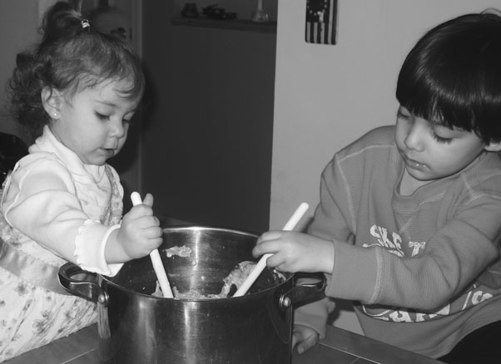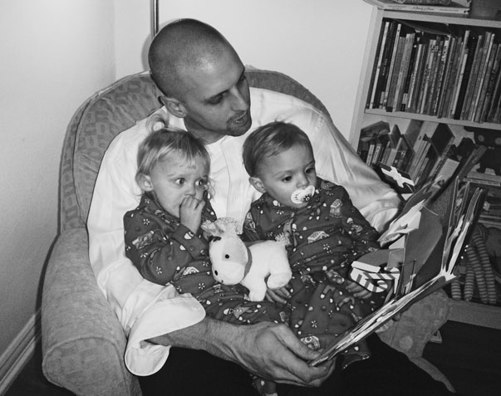The No-Cry Separation Anxiety Solution: Gentle Ways to Make Good-bye Easy from Six Months to Six Years (10 page)
Authors: Elizabeth Pantley
Tags: #0071596909

where he can observe without the pressure to interact with them. Take
walks around the mall or go to a busy park. Keep your baby close, and
let him look around and absorb his world and all the new faces in it.
Your child will look to you for cues that people are safe to relate to,
so be cheerful with cashiers, salespeople, or others you come across. If
one of these strangers talks to your baby, you can jump in and answer
on his behalf. If they attempt to reach out to touch or hold him,
you can swiftly interject that he’s “a little shy,” which is a universally
accepted reason for his hesitance.
No-Cry Solutions for Babies and Toddlers
37
Rescue Your Baby as Soon as She Needs You
Separation anxiety doesn’t disappear fully in one day; it usually hap-
pens in fi ts and starts over a period of time. Your baby might accept
being held by someone, but minutes later decide it’s too much for her.
If she begins to look stressed or starts to cry, then go ahead scoop her
back up immediately (if you can). You don’t need to passively watch
someone trying to calm your crying baby. A brief explanation helps
ease the discomfort of the situation: “Oops. She still has some sepa-
ration anxiety, and it looks like it just kicked in.” Most people will be
relieved that you took care of your crying baby so quickly.
If your baby is pushed beyond her comfort level, she may tighten
up her reins on you and resist the next attempt. Allowing her a res-
cue when she calls for it means she’ll be willing to try again. Short,
pleasant experiences will naturally grow into longer ones.
Preintroduce Your Baby to New People
To prepare your baby for upcoming times with unfamiliar people,
show her home movies and photos the week before the visit. If your
child likes books, then make a homemade book of photos to share
with her as you talk about these lovely people.
When they fi nally arrive in person,
you
should hug and greet them
fi rst and call them by name, so your baby can make the connection
between the photos and the actual people.
Eat, Drink, Rest, and Be Merry
A child who is well rested will make new friends or adapt to a parting
from Mom or Dad much easier than a tired one. Tired children have
shorter fuses—you can take their normal comfort zone and divide
that in half!
A hungry child can also be too uncomfortable to adapt. Children
cannot always identify their discomfort as hunger, and when they are
out of sorts they naturally gravitate toward the person who knows
them best and who can alleviate their discomfort.

38 The No-Cry Separation Anxiety Solution
Alyssa, two years old, and Matthew, four years old
A baby who is well rested and not feeling hungry will be in a bet-
ter mood to socialize or explore new situations.
Avoid Excess Separation During Peak
Anxiety Phases
It is perfectly okay to avoid separating from your child during peaks
in separation anxiety, since these phases usually pass more quickly if
allowed to follow a more relaxed path. It’s also not the time to sched-
ule a prolonged absence from your child, such as a daylong shopping
trip, a lengthy session at the health club daycare center, or an over-
night at a relative’s home.
If you need to separate from your child during peak times of anxi-
ety, choose the babysitter carefully. Beyond the basics of someone
who is capable of giving good care, look for someone who is sympa-
thetic to your child’s anxiety and will respond with gentleness and
patience.
No-Cry Solutions for Babies and Toddlers
39
Yet don’t take avoidance to the extreme and become hermits
because your baby is nervous about new situations or meeting new
people! Instead, take it slow and easy, and you can help your child
grow out of this stage sooner and easier.
Monitor Your Responses
If you are nervous about leaving your baby, she will pick up on your
feelings. She’ll take cues about how to act directly from you. Show
your confi dence: your baby will be in good care while you are apart
and will likely have fun once she adjusts to your departure. So stay
calm, confi dent, and relaxed so you can pass these emotions on to
your child.
Downplay your return as well. If your baby struggled while you
were away and then you return to cover her head with kisses and tell
her how much you missed her, you inadvertently send the message
that separation is, indeed, a big deal and something to be feared.
Instead, greet her with a hug and a friendly yet calm reunion. Keep
your voice cheerful: “Hi, sweetie! Did you play with your new blocks
while I was gone?” This tells her that the separation is normal, the
reunion with you is ordinary life, and the parting was nothing to
worry about.
Build on Good Experiences
If you have a successful separation event, try to re-create it within
a few days. Don’t wait too long, as the optimistic mood is best kept
alive if you act quickly. A growing store of positive experiences will
build your child’s confi dence.
This page intentionally left blank

3
The Magic Bracelet Solution for
No-Cry Separation
What is the only thing that would completely eliminate sepa-
ration anxiety? Eliminating the separation, of course! If your
child could take
you
along wherever he went, then all would be well.
Since that is clearly impossible, you can do the next best thing—pro-
vide your child with a memento that gives him a feeling of security
and is a visible token of your love when you are apart. I’ve discov-
ered that an easy-to-wear, accessible memento that works for boys
and girls of all ages is the Magic Bracelet. Think of the bracelet as
a portable you
—
albeit a you that is squashed, fl attened, and worn
around your child’s wrist.
In the same way that a well-loved blanket or a stuffed animal
lovey is a transitional object to help your child feel secure when leav-
ing you at bedtime, the Magic Bracelet is a transitional object to help
him separate from you with confi dence during the day (and can be
used as a sleep-time aid as well). It is a tangible reminder of your love
and care that can be worn easily all day long, may be touched or
viewed whenever necessary, and carries with it a portable and easily
accessible sign of comfort and affection.
Let’s look at how one mother, Christine, used the Magic Bracelet
to help her son. She fi rst e-mailed me with this plea:
Dear Elizabeth,
I’m writing because of my six-year-old son, Lucas. He just started kin-
dergarten and is having great diffi culty separating from me. He misses
me too much, and he doesn’t want to go to school. He cries every
morning at home and then cries when I drop him off at school. It
41
42 The No-Cry Separation Anxiety Solution
breaks my heart to walk away when he is in such a state, and it starts
the day off on such a horrible note for both of us.
When I pick Lucas up from school, he seems okay and says he had
fun. The teacher tells me that he settles in and functions well during
the school day. However, by bedtime he is anxious and worried about
school again. He isn’t sleeping well, and he barely eats breakfast or his
lunch on school days. . . . I know it’s because he’s nervous.
Is this normal behavior? Is there anything I can do to help him? I
have spoken to his teacher. She says it’s not uncommon and to give it
time. Yet it’s so diffi cult to leave him in such a state every morning. I
worry about Lucas all day long.
I would appreciate any advice you could offer me. I’m having a hard
enough time with the adjustment of him going off to kindergarten,
but add his crying and pleading into the mix and I feel absolutely
terrible. :(
Thank you for your time. I hope to hear back from you soon!
Sincerely,
Christine, mother of six-year-old Lucas and four-year-old Levi
I wish I could have hugged Christine and her little Lucas right then
and there! I could feel her pain, because I’ve lived through it before,
and I also understood her little boy’s uncertainty and fear. I could
imagine the stress and frustration their mornings held.
I wrote back to Christine and assured her that Lucas was very
normal. Making the move to kindergarten is a big step in a child’s
life (see Chapter 4). I gave her hope that we could work it through.
I sent her some information and a whole list of tips and gave her
instructions on how to create and use a Magic Bracelet. Her next
note arrived an astonishingly short six days later:
Hi, Elizabeth!
Thank you! Thank you! Thank you! Thank you! :)
I followed all your ideas this week, and I made a bracelet for Lucas
immediately after receiving your e-mail. I gave it to him the next
morning, explaining that it carried my love in it. I held it to my heart,
gave it hugs and kisses, and told him that anytime he felt sad or missed
me, all he had to do was touch the bracelet and he would feel my love.
The Magic Bracelet Solution for No-Cry Separation
43
His face brightened up! It was like the key to peace for him. He really
liked this idea, and off he went to school—actually smiling!
We are now fi ve school days, absolutely, wonderfully, 100 percent
tear-free! :O
He asks me every morning to “put my love” into the bracelet
and happily puts it on. Today, as we were leaving for school, he said,
“Thank you, Mama, for making me this bracelet. It helps me a lot.”
I was speechless.
I can’t begin to tell you how much this has changed our home.
Thank you sooo very much!
My four-year-old son, Levi, just started preschool, so I made one
for him too. He was doing okay (anything is okay compared to Lucas’s
problems), but the bracelet has made our mornings with Levi much
easier too.
I have spoken with several other parents at school who are hav-
ing separation issues as well and have told them your advice and the
results we’ve seen. There will probably be a few more preschoolers
and kindergartners walking around school with Magic Bracelets next
week.
You have my sincere and heartfelt thanks, and I am sure Lucas’s
thanks as well.
Fondly,
Christine
Your Child’s Magic Bracelet
The fi rst step to putting this idea into practice is to fi nd or make the
perfect bracelet for your child. The actual bracelet style is not what’s
important (this isn’t about fashion)—it is the power it holds. You can
receive a free Magic Bracelet by following the instructions provided
on my website a
t www.nocrysolution.com.
No matter which bracelet you decide to use, you may discover that
it becomes a cherished part of your little one’s separation confi dence.
If that’s the case, you’ll want to have one or two more as backups
in case the original bracelet is lost or damaged, as is common with
young children’s belongings.

